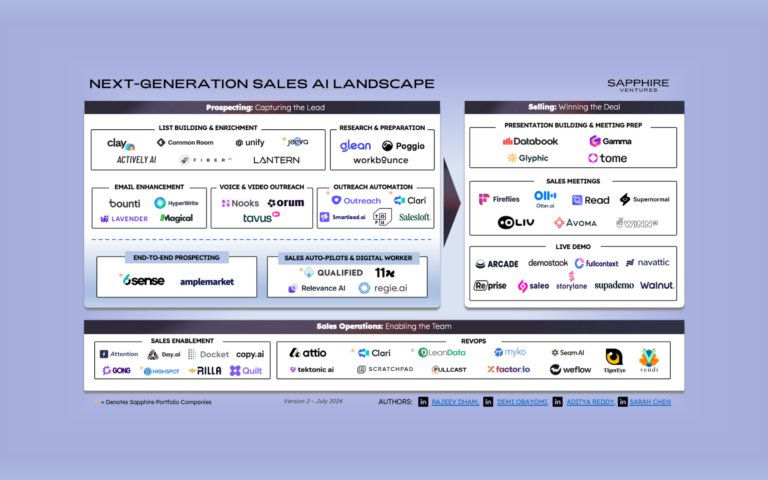We’ve seen it a number of times at Sapphire Ventures with growth-stage technology companies: you’ve nailed the transactional sales model — selling at a high velocity to a group of mid-level leaders (data analysts, developers, sales operation leaders) — but now you want to go hunting for enterprise-wide deals with c-level executives so you can land larger multi-year contracts.
Let’s be candid: enterprise sales can be arduous, messy, and resource intensive. Before you even start to assess your readiness to sell to enterprises, you should ask yourself one basic question: Why do you want to add an enterprise sales motion to your GTM engine?
If you’re currently expanding your accounts at a high rate and your sales cycle is efficient and short, you need to think long and hard about the value of adding a new sales motion to your current go-to-market (GTM) function. Selling to technical users helps your company build important skills and habits. It leads to predictable revenues, helps create pattern recognition around successful sales tactics, and reduces the risk in having one or two deals make or break your quarter’s performance. That being said, for companies that have serendipitously landed a few enterprise deals and feel adding an enterprise sales motion can position your solution as a more strategic resource to your customers then courting enterprise buyers could be a valuable lever of growth. Ross Mason CTO and Founder of Mulesoft said his company started focusing on enterprise buyers because…, “We realized fairly early on that the problem we solve is pretty complicated and the sales cycle will be nine months, whether you’re spending 50K or five million with us. We just realized if that’s the way it’s going to be for the time being, what we should do is optimize for doing massive transformations first and then back into smaller ones as we got scale.”
Regardless of your reason, if your company does decide to pursue enterprise buyers then you should be prepared to answer four key questions to assess your readiness to sell to enterprise.
1. Do you have the right people and teams?
Enterprise sales require a high-touch engagement to navigate a jungle of corporate stakeholders. Your sales team will need to know how to cultivate a breadth of relationships across an organization and how to create a groundswell of corporate champions who you can guide to the right business decision – not necessarily a technology decision. Enterprise sales professionals are expected to bring something to the table. (How will your solution improve a situation? Improve their industry standing? Make a bigger name for the company?) These are big questions that require heavy research to answer correctly.
To achieve this, you’re going to need sales professionals who can not only conduct a sophisticated business conversation with a C-level executive, but can also be viewed as trusted advisors who bring a consultative approach to your customers. To do so, enterprise sales professionals need to develop a deep understanding of their customers’ business to understand their respective industry and specific business issue(s), which include reading customers annual reports to understand whether a prospect or customer’s business issue(s) is trying to increase revenue; bring down operating costs; mitigate risk; delight customers or delight employees.
Once you have the right people, aligning them on a “Strategic Account” team will free them to operate outside of your current GTM construct. For example, if you want to encourage your sales team to close long term contracts then you may want to offer a SPIFF (sales incentive) or pay an accelerated rate on those deals. When your company is selling lower ACV deals, you’ll pay your reps a lot more of the deal size, but the marketing costs are lower too. As you move to enterprise buyer sales, with higher ACV, you can expect the sales and marketing cost structure to inverse.
Lastly, is your marketing team equipped to support an enterprise sales motion? The relationship between marketing and sales will need to become much more aligned than it most likely is in a more self-service oriented sales model. Field marketing will become a core function of your marketing team to help your sales teams better understand and articulate how your solution can uniquely address your customers’ specific business issue(s)… On that note, your material will need to become much more targeted and focused on solving business issues within industry verticals.
InfluxData, a Sapphire portfolio company, has built a Strategic Sales Team that manages the company’s named accounts. This team is responsible for nurturing these accounts, being a trusted advisor to enterprise buyers, aligning their technology with customer’s strategic initiatives, and helping to build enterprise-wide use cases for their technology.
2. Does your messaging speak to a CXO audience?
Many high growth technology companies early on (and rightfully so) have relied on inbound sales and/or product-led growth to fuel their sales engine. In these cases, high growth companies have targeted corporate technical users not executive buyers. Many companies in this self-service GTM motion focus their messaging on the technical specifications, the simplicity of use, and the specific pain points they solve. As you move up the corporate ladder and add an enterprise GTM motion, you will need to align your messaging more with business outcomes and value than on how innovative your technology is. Put simply, enterprise buyers care about the things you solve while technical buyers care mostly about the things you do.
A good litmus test of your enterprise sales message is, could the CIO – after hearing your pitch – champion to their CEO how your solution fits into their larger business priorities? Your messaging needs to show how your solution impacts key business metrics for that executive buyer. For example, if you are a data technology company:
- DO communicate how your solution drives top-line business outcomes, such as helping to drive X amount of revenue or driving down Y% in operating costs.
- DON’T just message how your solution eloquently routes data and reduces data prep, since the business executives you’ll be pitching to don’t typically deal with these issues on a day to day basis.
This doesn’t mean not giving context about your product, but your messaging should clearly be tied to a business need that executives care about.
Aaron Levie from Box aptly said, that the questions that Box needed to answer when moving up to sell to CXOs was “How do we become a strategic part of the IT architecture? How do we actually build one of the key pillars of their enterprise?”
3. Are your product and process prepared for enterprise-wide sales opportunities?
What may have worked from a product portfolio mix for selling to individual users may not be ideal for selling to enterprise buyers. Make sure to evaluate your product offering to see if it will match expectations of targeted enterprise buyers and your modified messaging.
Additionally, be sure to revisit your current pricing model. Does your current solution pricing provide the correct incentives for large enterprise accounts? In some cases, companies will have pricing models that are based on consumption metrics and calibrated for smaller contracts, but will cause enterprise size contracts to reach their annual pricing threshold in a matter of months, which can cause for some tough discussions later on between you and your customer.
Finally, once you have received executive buy-in, you will most likely be handed off to procurement who will start the process of analyzing your product, evaluate you against other solutions, and negotiate pricing all over again. This final stage can derail a sales process so be prepared by having a strong business case — and executive champion — for your solution to push this through procurement.
4. Can you afford to be patient?
Executive corporate sales cycles tend to take considerably longer than when you sell to a technical user within the enterprise. Are you and your board willing to invest the time and capital necessary to build an enterprise sales motion for executive buyers?
In addition to taking longer, you will need to create or increase the size of your field team and potentially hire a specialized overlay sales team for strategic enterprise accounts. This will need to coincide with amping up of your marketing capabilities to invest into different channels such as events, analyst relations, customer success programs, and solutions-selling oriented content for your sales teams.
Making the shift
The rewards of nailing an enterprise sales motion can be big, but it will also put stress on your organization. While technical users can be more forgiving and willing to ignore product shortcomings to enjoy your product’s primary benefit, executive buyers will be less lenient. They will be demanding and often require extra attention or customization that you will need to decide if you are prepared to offer or not. Be sure to think through the answers to the four questions above BEFORE you start investing heavily into the new sales motion so you don’t waste your precious resources. Once you decide to seek enterprise deals and you start pursuing the office of the CIO or CTO, be sure to read Shruti Tournatory’s post on how to nail your executive meetings.
Good luck!




